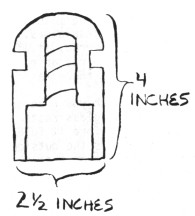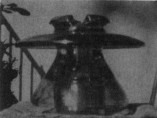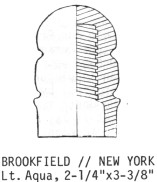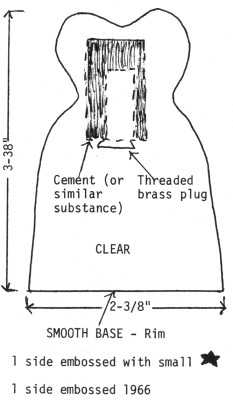Questions Answered by N. R. Woodward
Author of The Glass Insulator in America and originator of C.D. #'s (Consolidated Design Numbers)
Reprinted from "INSULATORS - Crown Jewels of the Wire", April 1975, page 13
Fran Miller, Duluth, Minnesota, writes: I have a question, and I was
wondering if you or anyone has an answer. On the front of a Hemingray-12 clear
there is 0-4. and the Hemingray-42 front, 8::: Do these dots and numbers
represent something? Also on many other insulators, such as Hemingray-9, 0-4. or
13-54::.
- - - - - - - - - -
In reply to Fran Miller: All of the numbers and dots appearing on the
insulators have a meaning. In some cases we are not absolutely certain of them;
but at this time we have sufficient evidence so that we can be reasonably
certain of a majority.
Other than the style numbers which are obvious to most persons, there are
primarily three reasons for the markings. First, there are the shop numbers
which were used primarily on older insulators to indicate which press they came
from when they emerged from the annealing lehr for packing. These numbers were
needed where more than one crew was making the same insulator style. They
identified the source of the insulators for the purpose of tracing any fault in
the finished product, and more importantly, to identify the source of the
insulators where the workmen were paid by piece work, on the basis of number of
insulators they produced.
Second, and most common on newer insulators, are the mold numbers. These are
simply serial numbers engraved into the molds which, as the above, give
immediate identification as to the exact mold on the press from which an
insulator came. Virtually every insulator has had a mold number since the early
1930's, and many had them earlier. The molds were made in sets, usually
consisting of many more than would be used at any one time. Thus it would be
possible, for example, that a 12- mold press might be operating with molds No.
2, 10, 11, 14, 20, 21, 25, 35, 36, 37, 39, and 45 at one specific time. In cases
where a line was built, or rebuilt with new insulators, it is possible to
reconstruct the group of molds that was used for that particular production by
checking several poles. But to locate the missing numbers, one might have to go
to another part of the country and locate insulators made from a different run.
Third, are the date numbers and codes. These did not appear on most
insulators until the mid-1930's. They are often grouped together with the mold
numbers, uniformly so since the late 1940's. They indicate both the year the
mold was made and the year the insulator was made.
To go into a complete description of all of these would not be practical
here, since the interpretation does not always run the same for the same marking
on different insulators. In the examples you gave, 13-54::. indicates as
follows: 13 is the mold number. 54 is the year the mold was made; or, in other
words, it designates the mold set. The dots were added into the mold, one for
each year, to give the year of manufacture of the insulator, in this example,
1959. Incidentally, though, I don't believe this came from a Hemingray-9, did
it? More likely a Hemingray-45. There was no 54 mold set in 9 so far as I know.
Their last was the 52 set for CD #106, followed by the 56 set for CD #107.
The 0-4 sets were earlier. They are the first date codes Hemingray used; or,
more correctly, they were added about the time Owens-Illinois took over.
Although we have no definite documentation, it is believed the 0-4 sets were
begun in 1934. Every indication points in this direction. The 0-4. marking
would, of course, be 1935 production; and on these the mold number is on the
opposite half-mold.
The 8 mold sets are believed to have begun in 1938; but obviously the same
base year marking was used in some styles for several years thereafter, so that
not every mold with that marking was made in 1938. However, the dots carry the
same meaning, so that your 8::: would be 1944 production. It would be one of the
short No. 42, where the skirt was shortened during the war to make a somewhat
smaller and lighter insulator.
William Bramlett states: I have come across a C.D. 154 F. Hemingray 42 -
number and dots B. Made in U.S.A., with the Hemingray 42 in small embossing. I
would like to know if you have anything on it, how rare or what the price should
be.
- - - - - - - - - -
In reply to William Bramlett: The Hemingray-42's with small letters are the
latest ones. They are the 48 and 52 mold sets. They are not rare or especially
valuable; but at that time the Bell System Companies and Western Union had
adopted the style of Hemingray-45 as their standard, so these later 42's were
bought by the pipeline companies and others. Therefore they are not nearly so
common as those produced earlier.
From Robert L. Jensen, Vernal, Utah: I have a question on "ghost
embossing". I have a purple Hemingray-9 that has GRAY embossed across the
dome. It's faint, but still distinct. What causes this, and does it occur during
the regular embossing process? I'm sure much has already been written about such
things, but I have never seen anything on it and sure would like to know.
Thanks.
- - - - - - - - -
In reply to Robert L. Jensen: The term "ghost embossing" is used to
refer to two entirely different things. First, it is well to remember that there
is not an "embossing process", but rather an engraving of the molds,
which results in the embossing appearing on the molded insulators. One type of
"ghost embossing" results when the engraving in the mold was covered
in order to alter the lettering on the insulators. If the original lettering was
not completely covered, it will show through on insulators made later, sometimes
readable, but more often sufficient only to indicate that there was engraving
there before.
The second type of "ghost embossing", which you have on your purple
9, results when the molten blob of glass rests for a fraction of a second
against engraving before it folds into the bottom of the mold and sets.
Sometimes the outside of the glass blob cools at that instant just enough that a
few letters will show up where they don't belong. More often they appear on the
skirt just above the regular embossing, where they were picked up when the glass
hit bottom and came to rest before the mandrel was brought down to force it into
its final form. In this type, the letters are usually distorted to some extent,
and often larger than the engraving, since the glass is still pliable, and the
letters tend to spread out.
Frank Shiels, Fort Worth, Texas, writes: After I had purchased about ten
insulators from a friend, I noticed that the C.D. 202, Fred Locke, had the date
1894 instead of 1884. Could this be a misprint? And if so, is it worth any more
to other collectors?
- - - - - - - - - -
In reply to Frank Shiels: The CD #202, Locke No. 14, is commonly lettered:
PAT. MAY 22 1894. This date refers to Fred Locke's patent covering a
transposition insulator; but it appears likewise on various Locke styles that
are not transpositions.
From Oval Brown; I have an insulator here that you may know something about.
It is a very light blue, with nothing on the bottom. There is a large 23 on the
crown. It is hard to make out some of the letters, but one side of the dome is
embossed PAT NOV 13 1883 FEB 12th 1884, and on the other side W BROOKFIELD 45
CLIFF N.Y.
- - - - - - - - -
In reply to Oval Brown: Your insulator is a Brookfield, of which many
millions were made for Western Union and the railroads. Now, after 85 or 90
years, they are still not difficult to find on lines along railroad rights-of-way. They were the standard for Western Union during the fastest part of its
early growth period, while iron wire lines were covering the U. S. The large 23
on the crown is a shop number. Most of these insulators have such a number,
since many of the primitive presses of those years would be operated at one time
to supply the need, and the numbers identified their source within the plant.

From Paul Thornquist, Whitefish Bay, Wisconsin, Here is a sketch of an
insulator I have which has been puzzling me. One side is embossed HEMINGRAY
1-42, and the other side C.S.C. I would appreciate any information on this item.
I'm 16, been collecting for two years, and have a collection of about 70
insulators, mostly common. My mother insists I'm crazy for collecting
insulators, but I don't care.
- - - - - - - - - -
In reply to Paul Thornquist: Your insulator is a carrier insulator. This
style was first used in the mid-1920's. It was developed for high-frequency
carrier circuits used by the Bell System for long distance phone calls,
wirephoto and other data transmission, and later for television programs. Thirty
years ago there were thousands of miles of carrier wire in service in the U. S.
Now, nearly all transmission is by microwave and cable. In the Western
mountains, one can still find open wire carrier lines.
The CSC insulators were designed for use on steel pins with a lead (or later,
plastic) thimble between the steel threads and the glass to prevent cracking of
the glass due to thermal change. Since these lines had to be transposed
frequently, the CSC insulators were used on the four-point transposition
brackets as well.
Your CSC was made in mold 1, 1942 mold set. If there are no dots after the
42, the insulator was made in 1942. If there are dots, add one year for each
dot.

Dave Collins, Lafayette, California, writes: I'm enclosing a photo of an
insulator that I've had for some time. I picked up this gem in Maryland last
summer, and I'm having trouble identifying it. It stands roughly 8- 1/2 in. tall
and 7-1/2 to 8 in. wide (at the shoulder). The inscription reads, "PYREX
T.M. REG. US PAT. OFF. MADE IN USA-453-". I hope someone can help me with
this, as to age, etc. The color is an iridescent carnival.
- - - - - - - - -
In reply to Dave Collins: Your Pyrex No. 453 is one of Corning's standard
items, rated at 45,000 volts. Corning began its line of power insulators in
1923; and they were offered until about 1941 .
The history of the iridizing is a bit more difficult to trace; but it is
likely that your particular unit is from the mid-1930's. The first iridized
insulators were the smaller sizes and were made that way for use as
"marker" insulators for power supply wires in railway signal systems.
In 1935 Western Union began a program of experimental iridizing of communication
insulators, because it was found that the iridizing had some beneficial effects
on the quality of insulation afforded. Subsequently there was some conflict
between Corning and Western Union over patents covering the process; but
evidently nothing came of it, because in the late 1930's both Corning and
Hemingray made numerous iridized insulators of various styles. Your specimen
would probably place during that period, or toward the last of the Pyrex power
insulators.

From Mark Willke, Gresham, Wisconsin: I have a few questions about
insulators.
First of all: I was given an insulator which looks something like a CD. 112
(see picture), but it is bigger around than a normal CD. 112, and it also has a
different type of bottom wire groove than on normal C.D. 112's. I would
appreciate any information on this insulator.
Second: I have a C.D. 134 which says "HEMINGRY",
instead of "HEMINGRAY". The back reads PATENT MAY 2, 1893. This
insulator is aqua, with sharp drips. Is it worth anything more because of the
misspelling?
Last of all: This may sound like a stupid question, but here goes. Is the
word "HEMINGRAY" pronounced HEM-IN-GRAY, or HEM-ING-RAY?
Thank you for your help.
- - - - - - - - -
In reply to Mark Willke: First: Your Brookfield CD #112 is a variation. That
particular CD number covers almost endless variations. They are so close
together that any thought of separating them in a practical manner is almost
impossible! Yours is often spoken of as the "keg".
Second: I haven't seen the CD #134 with "HEMINGRY". Errors in
Hemingray lettering are not extremely numerous and are of interest to
"error" collectors. It would probably be true that your insulator
would be worth more because of the error, to collectors who specialize in them.
But insofar as I know, there have been no extremely high values established for
errors in common insulators.
Third: According to those who have been associated with the Hemingray plant,
the correct pronunciation would be Hem-ing-gray. That would be the same as Ernest
Hemingway's name is pronounced, except "gray" in place of
"way".
Matt Hauffman, Baltimore, Maryland, states: I have a question for Mr.
Woodward. I collect CD 102's specifically. I have a heavy, unmarked piece which
was made in a 3 piece mold. But it appears the mold was hand made with a
ballpeen hammer. The imprint is all over the insulator on the outside only;
otherwise, the insulator is shaped symmetrically, with a shallow wire groove. I
haven't seen another like it, although I haven't been to too many shows. I
wonder if I could get a little history about the insulator, or the real process
by which it was made.
- - - - - - - - -
In reply to Matt Hauffman: Sorry, I've not seen the insulator and can make no
comments!

From Don Mac Gready, Hillsdale, New Jersey: I thought perhaps you could
identify an insulator sent to me on approval by a dealer. He doesn't seem to
know what it is, but claims it's foreign. He's asking,$10 for it. It looks like
the sketch at the left.
- - - - - - - - - -
In reply to Don Mac Gready: I do not know the origin of your insulator! I
would agree with the seller that it is definitely a foreign item; and his price
would seem in line with what is being asked for such items. I'm sure the star
bears no relationship to U. S. "Star" insulators. If you can find out
what country it came from, let us know!
| 